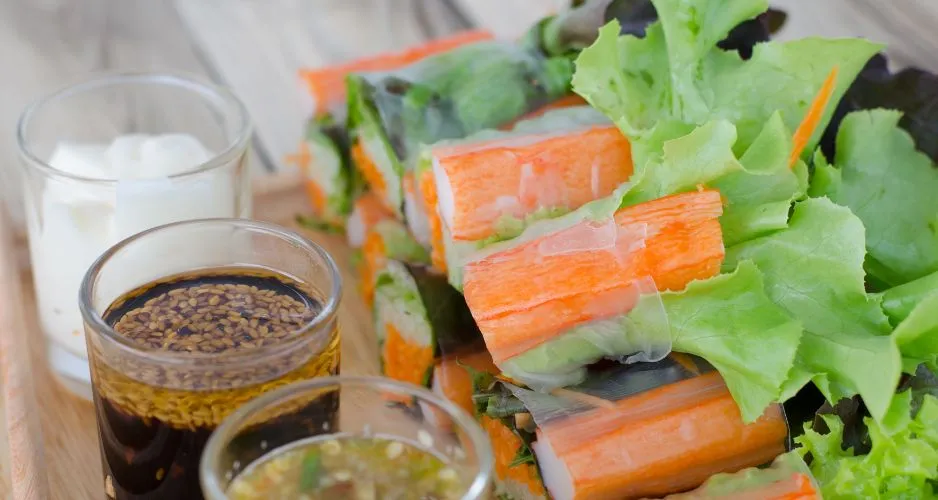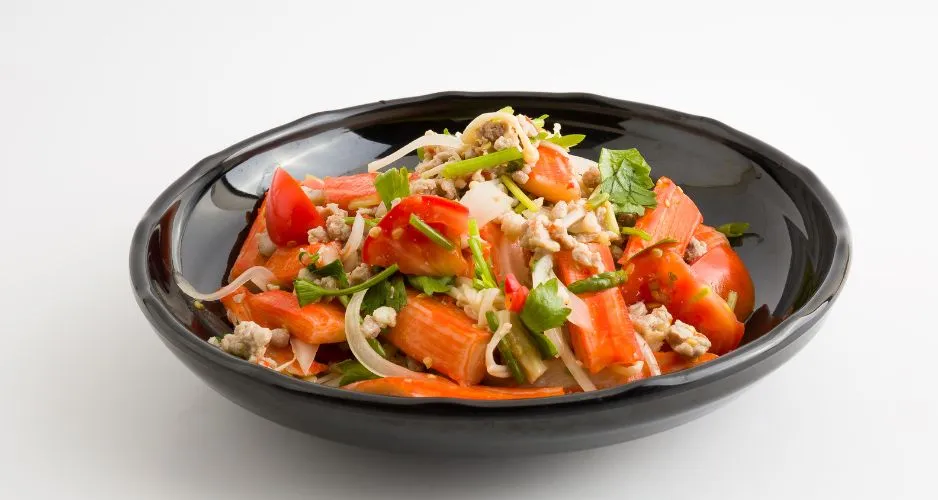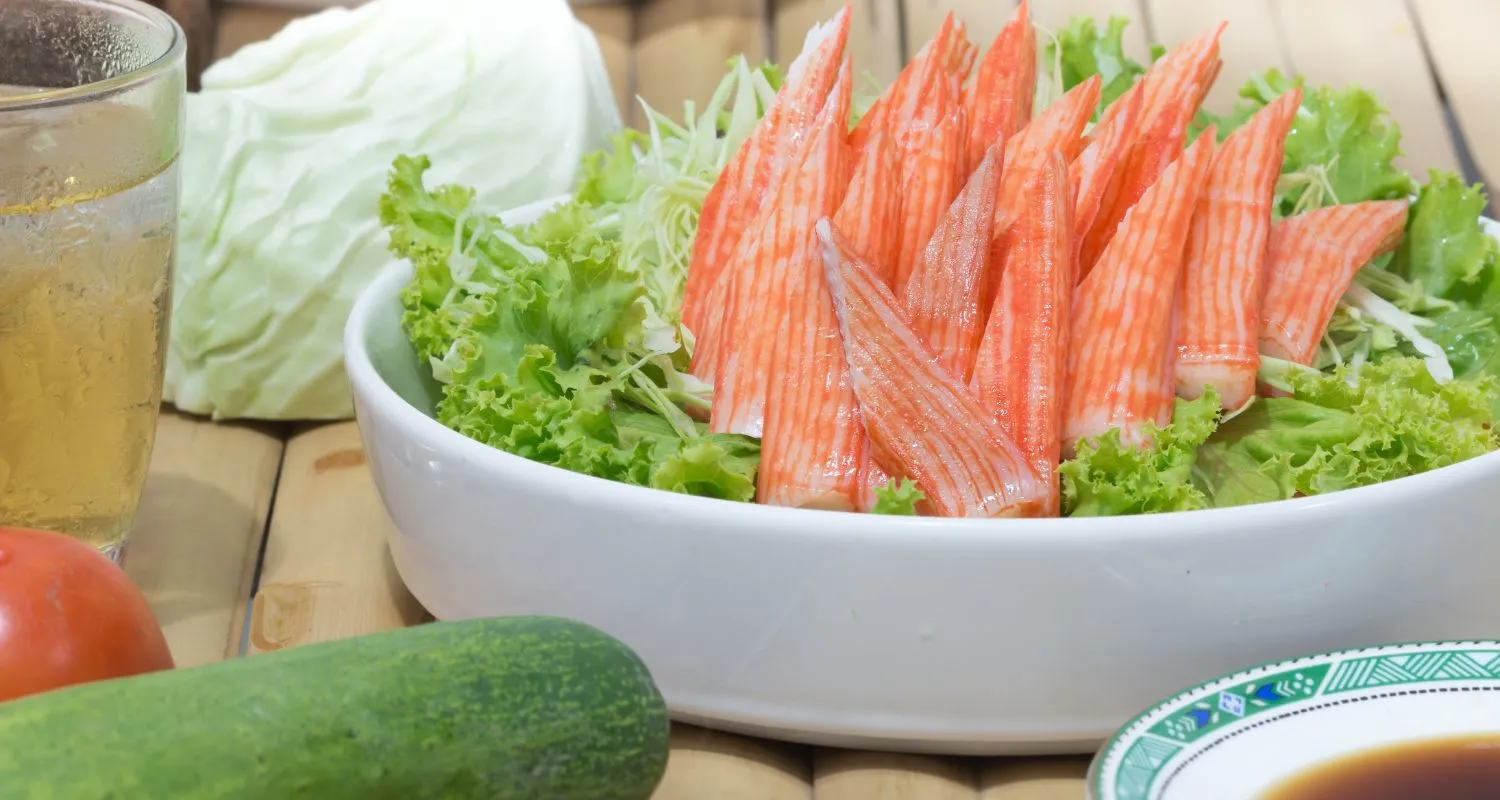Diving into the world of culinary delights, imitation crab stands out as a versatile and budget-friendly ingredient that brings the essence of the sea to your plate without breaking the bank. In this comprehensive guide, we’ll explore the ins and outs of imitation crab recipes, unraveling the mysteries of this popular seafood alternative. From the basics of what imitation crab is to a plethora of mouth-watering recipes, cooking tips, and nutritional insights, we’ve got you covered. Whether you’re a seasoned chef or a curious foodie, prepare to embark on a flavorful journey that promises to enrich your cooking repertoire and tantalize your taste buds.
Introduction to Imitation Crab Recipes
What is Imitation Crab?
Imitation crab, a marvel of culinary ingenuity, is a type of seafood made from surimi—a fish paste usually derived from pollock. Seasoned and colored to mimic the taste and texture of real crab meat, it’s a staple in various cuisines around the globe. Its affordability and ease of use have made it a favorite among home cooks and professional chefs alike.
Why Use Imitation Crab in Recipes?
Opting for imitation crab in recipes is not just about cost-saving; it’s also about versatility. This ingredient adapts seamlessly to a wide range of dishes, from salads and dips to sushi rolls and casseroles. Moreover, it’s a convenient option, often sold pre-cooked and ready to eat, cutting down on preparation time and making it a go-to for quick and easy meals.
Imitation crab opens up a world of culinary possibilities, allowing you to explore a variety of flavors and textures. Whether you’re whipping up a quick lunch or planning an elaborate dinner, it’s an ingredient that promises to elevate your dishes with its unique charm. So, let’s dive into the delicious world of imitation crab recipes and discover how to make the most of this versatile seafood alternative.
Popular Imitation Crab Recipes
Embark on a culinary adventure with these popular imitation crab recipes. Each dish is crafted to highlight the versatility and delightful taste of this accessible seafood alternative. From comforting dips to sophisticated entrees, discover the joy of cooking with imitation crab.
Sensational Crabmeat Fondue
Ingredients:
- 1 cup imitation crabmeat, shredded
- 1 cup cream cheese, softened
- 1/2 cup mayonnaise
- 1/4 cup green onions, chopped
- 1 cup Swiss cheese, shredded
- 1 teaspoon garlic powder
- Salt and pepper to taste
Directions:
- In a mixing bowl, combine cream cheese, mayonnaise, garlic powder, salt, and pepper until smooth.
- Fold in the imitation crabmeat, Swiss cheese, and green onions.
- Transfer the mixture to a fondue pot or a slow cooker. Cook on low heat, stirring occasionally, until the cheese is melted and the mixture is hot throughout.
- Serve with bread cubes, crackers, or vegetable sticks for dipping.
Hot Crab Dip
Ingredients:
- 2 cups imitation crabmeat, chopped
- 1 cup sour cream
- 1 cup cream cheese, softened
- 1/2 cup grated Parmesan cheese
- 1/4 cup green onions, sliced
- 2 tablespoons Worcestershire sauce
- 1 tablespoon lemon juice
- 1 teaspoon hot sauce (optional)
- Salt and pepper to taste
Directions:
- Preheat your oven to 350°F (175°C).
- In a large bowl, mix together the sour cream, cream cheese, Parmesan cheese, Worcestershire sauce, lemon juice, hot sauce, salt, and pepper until well combined.
- Gently fold in the imitation crabmeat and green onions.
- Transfer the mixture to a baking dish and spread evenly.
- Bake in the preheated oven for 25-30 minutes, or until the top is golden brown and bubbly.
- Serve warm with crackers, sliced baguettes, or vegetable sticks.
These recipes are just the beginning of what you can create with imitation crab. Experiment with different ingredients and flavors to make these dishes your own. Whether you’re hosting a party or looking for a comforting meal, these imitation crab recipes are sure to impress.
Advanced Imitation Crab Recipes
Elevate your culinary skills with these advanced imitation crab recipes. Each dish is designed to impress, blending the simplicity of imitation crab with sophisticated flavors and presentation. Perfect for special occasions or when you’re looking to treat yourself, these recipes showcase the versatility and elegance of this accessible ingredient.

Baked Crab Dip
Ingredients:
- 2 cups imitation crab meat, shredded
- 1 cup cream cheese, softened
- 1/2 cup sour cream
- 1/4 cup mayonnaise
- 1 cup shredded sharp cheddar cheese
- 1/4 cup grated Parmesan cheese
- 1/2 cup green onions, chopped
- 2 cloves garlic, minced
- 1 tablespoon Worcestershire sauce
- Salt and pepper to taste
- 1/4 cup breadcrumbs (for topping)
Directions:
- Preheat your oven to 375°F (190°C).
- In a large bowl, mix together the cream cheese, sour cream, mayonnaise, cheddar cheese, Parmesan cheese, green onions, garlic, Worcestershire sauce, salt, and pepper until well combined.
- Gently fold in the shredded imitation crab meat.
- Transfer the mixture to a baking dish and smooth the top with a spatula.
- Sprinkle breadcrumbs evenly over the top.
- Bake for 25-30 minutes, or until the top is golden brown and the dip is bubbling.
- Serve hot with crackers, sliced baguette, or vegetable sticks.
Shrimp & Crab Pizza
Ingredients:
- 1 pre-made pizza crust
- 1/2 cup pizza sauce
- 1 cup imitation crab meat, shredded
- 1 cup cooked shrimp, chopped
- 1 cup mozzarella cheese, shredded
- 1/2 cup red onion, thinly sliced
- 1/4 cup bell pepper, diced
- 2 tablespoons fresh parsley, chopped
- 1 tablespoon olive oil
- Salt and pepper to taste
Directions:
- Preheat your oven to 425°F (220°C).
- Brush the pizza crust with olive oil and spread the pizza sauce evenly on top.
- Sprinkle half of the mozzarella cheese over the sauce.
- Distribute the imitation crab meat, shrimp, red onion, and bell pepper evenly over the cheese.
- Top with the remaining mozzarella cheese and season with salt and pepper.
- Bake for 12-15 minutes, or until the cheese is melted and bubbly and the crust is golden brown.
- Garnish with fresh parsley before serving.
These advanced recipes are just the beginning of what you can achieve with imitation crab. By experimenting with different flavors and ingredients, you can create a wide range of sophisticated dishes that highlight the versatility and appeal of this convenient seafood alternative.
Cooking Tips and Tricks
Unlock the full potential of imitation crab with these essential cooking tips and tricks. Whether you’re a novice in the kitchen or looking to refine your culinary skills, these insights will help you elevate your imitation crab dishes to new heights.

Preparing Imitation Crab
How to Choose the Best Imitation Crab
Selecting high-quality imitation crab is the first step toward creating delicious meals. Look for products with a short ingredient list, indicating fewer additives and a focus on quality. The texture should be firm yet tender, with a color that closely mimics that of real crab meat.
Preparing Imitation Crab for Cooking
Before incorporating imitation crab into your recipes, it’s crucial to prepare it properly. If it’s frozen, thaw it in the refrigerator overnight or under cold running water for a quicker option. For recipes requiring finer pieces, shred the imitation crab with your fingers or chop it with a knife to achieve the desired texture.
Cooking Techniques for Imitation Crab
Best Practices for Cooking Imitation Crab
Imitation crab is pre-cooked, making it a convenient option for quick meals. However, to maintain its delicate texture and flavor, avoid overcooking. Gently heat it through in dishes like soups, stews, or pasta to keep it tender and juicy.
Creative Ways to Incorporate Imitation Crab into Meals
Imitation crab’s versatility allows it to shine in a variety of dishes. Try adding it to creamy pasta sauces, stuffing it into enchiladas, or mixing it into a fresh seafood salad. Its mild flavor pairs well with bold spices, fresh herbs, and citrusy dressings, offering endless possibilities for experimentation.
By following these tips and tricks, you’ll be well on your way to mastering the art of cooking with imitation crab. Embrace the versatility and convenience of this seafood alternative to add a touch of elegance and flavor to your meals without the hassle.
Health and Nutritional Benefits
Imitation crab, while a convenient and tasty option for many, also comes with its own set of health considerations and nutritional benefits. Understanding these can help you make informed choices about incorporating it into your diet.
Nutritional Profile of Imitation Crab
Imitation crab is made from surimi, a fish paste usually derived from pollock, and then flavored and colored to mimic crab meat. It’s low in calories and fat, making it a lighter alternative to many other proteins. However, it’s important to note that it’s also lower in protein and omega-3 fatty acids than real crab meat. Additionally, because it often contains wheat and other additives, it may not be suitable for those with certain dietary restrictions or allergies.
Comparing Imitation Crab to Real Crab
When comparing imitation crab to real crab, there are several nutritional differences to consider. Real crab is richer in protein and omega-3 fatty acids, which are beneficial for heart health, brain function, and inflammation reduction. Real crab also contains vitamins and minerals like vitamin B12, zinc, and selenium, which are less prevalent in imitation crab.
However, for those looking for a low-calorie, low-fat option, imitation crab can be a suitable alternative. It allows individuals to enjoy the flavor of crab without the higher cost or dietary fats. It’s also a convenient choice, as it’s pre-cooked and can be easily added to a variety of dishes.
Incorporating imitation crab into your diet can offer a balance between convenience, taste, and nutrition. As with any food, moderation is key. Pairing imitation crab with a variety of other healthy ingredients can help you create balanced, nutritious meals that cater to your dietary needs and preferences.
FAQs
Navigating the world of imitation crab can spark curiosity and questions, especially for those new to this versatile ingredient. Here are some frequently asked questions that can help demystify the process and inspire confidence in your culinary adventures.
What are the best dishes to make with imitation crab?
Imitation crab shines in a variety of dishes, from appetizers like dips and salads to hearty mains such as pasta and casseroles. Its mild flavor and tender texture make it a fantastic addition to sushi rolls, seafood chowders, and even as a filling for wraps and sandwiches. Experimenting with different recipes can help you discover your favorite ways to enjoy imitation crab.
Can I substitute real crab with imitation crab in any recipe?
Yes, imitation crab can be used as a substitute for real crab in most recipes. However, it’s important to consider the differences in flavor and texture. Imitation crab is milder and slightly sweeter than real crab, so you may want to adjust seasonings accordingly. It’s an excellent alternative for budget-friendly cooking without sacrificing the essence of seafood in your dishes.
How do I store leftover imitation crab dishes?
Leftover dishes containing imitation crab should be stored in an airtight container in the refrigerator. Consume them within two days for the best quality and safety. If you’ve used fresh imitation crab, you can also freeze the leftovers. Be sure to thaw them properly in the refrigerator before reheating and serving.
What is the best way to eat imitation crab meat?
Imitation crab meat is versatile, allowing you to enjoy it in various dishes. Additionally, you can mix it into salads, sushi rolls, and seafood pasta for a delightful taste. Furthermore, incorporating it into dips and appetizers provides a seafood flavor without the cost of real crab.
Can you cook imitation crab?
Yes, you can cook imitation crab. Moreover, it’s already pre-cooked, making it suitable for quick heating or direct addition to dishes. However, it’s best to add it towards the end of the cooking process to prevent it from becoming too tough.
Is it healthy to eat imitation crab meat?
Imitation crab meat can be a part of a healthy diet when consumed in moderation. Nevertheless, it’s lower in protein and omega-3 fatty acids than real crab. Conversely, it’s often high in sodium and additives, so it’s wise to check the nutrition label.
Can you eat imitation crab raw?
Yes, you can eat imitation crab raw since it’s pre-cooked. Therefore, it’s ready to eat straight from the package, making it convenient for salads, cold appetizers, or sushi.
How to cook fake crab?
To cook fake crab, you can lightly pan-fry, bake, or stir-fry it. Additionally, it’s important to heat it gently to maintain its texture. Moreover, incorporating it into soups or pasta dishes at the last minute heats it through without overcooking.
What’s the point of imitation crab meat?
Imitation crab meat offers a cost-effective alternative to real crab. Furthermore, it provides a similar taste and texture for those who enjoy seafood but might be on a budget. Additionally, its ease of use and shelf-stability make it popular in various culinary applications.
Should I boil imitation crab?
Boiling imitation crab is not recommended as it’s already cooked and boiling can make it tough and rubbery. Instead, gently heating it through other methods, such as mixing into warm dishes, is preferable.
How to eat surimi?
Surimi, the primary ingredient in imitation crab, can be eaten in a variety of ways. For instance, you can add it to salads, sushi, and pasta dishes. Also, it’s delicious in crab cakes or as a filling for sandwiches and wraps.
How long does imitation crab last?
Imitation crab can last up to two months in the freezer and about 3-5 days in the refrigerator once opened. However, ensuring it’s stored properly in airtight containers is crucial to maintain its freshness.
Who invented imitation crab?
Imitation crab was invented in Japan in the 1970s as a way to utilize surplus fish. It has since become a global staple, offering a cost-effective seafood option.
Is imitation crab high in mercury?
No, imitation crab is not high in mercury because it’s made from surimi, a paste made from white-fleshed fish, which typically have lower mercury levels than other types of seafood.
How can you tell if fake crab is bad?
To determine if fake crab is bad, check for any unpleasant odors, discoloration, or slimy texture. These signs indicate spoilage, and the product should not be consumed.
What is the meaning of surimi?
Surimi is a Japanese term meaning “ground meat,” referring to a paste made from fish or other meat. It’s the base for making imitation crab and is celebrated for its ability to mimic the texture and flavor of more expensive seafood.
How much imitation crab can you eat?
While imitation crab can be enjoyed as part of a balanced diet, it’s wise to consume it in moderation due to its sodium content and additives. Balancing your intake with other nutrient-rich foods is key to a healthy diet.
Does imitation crab meat need to be cooked?
No, imitation crab meat does not need to be cooked since it is pre-cooked. It’s ready to be added directly to your dishes, offering convenience and ease of use.
Do you warm up imitation crab meat?
While not necessary, you can warm up imitation crab meat if desired. Gentle heating methods, such as microwaving for a short time or stirring into warm dishes, are suitable ways to enhance its flavor in hot meals.
These FAQs aim to clear up common concerns and encourage you to explore the delicious possibilities that imitation crab has to offer. With a bit of creativity and these helpful tips, you’re well-equipped to create delightful dishes that will impress your family and friends.
Conclusion:
As we’ve journeyed through the versatile world of imitation crab, from the basics and popular recipes to advanced culinary creations, it’s clear that this ingredient is a powerhouse of convenience and flavor. Whether you’re crafting a quick weekday meal or a sophisticated dish for a special occasion, imitation crab offers a world of possibilities for every palate and skill level.
Incorporating imitation crab into your cooking not only allows for culinary creativity but also introduces a range of dishes that can be enjoyed by everyone, regardless of their cooking expertise. With the tips, tricks, and recipes provided, you’re well-equipped to explore the delightful flavors and textures that imitation crab has to offer.
Remember, the key to great cooking is experimentation and personalization. Don’t be afraid to tweak recipes to suit your taste preferences and dietary needs. Imitation crab, with its mild flavor and adaptable nature, invites you to play with ingredients and discover new favorites.
As you continue to explore the culinary landscape, let the versatility of imitation crab inspire you to create dishes that are not only delicious but also reflective of your culinary journey. Happy cooking
